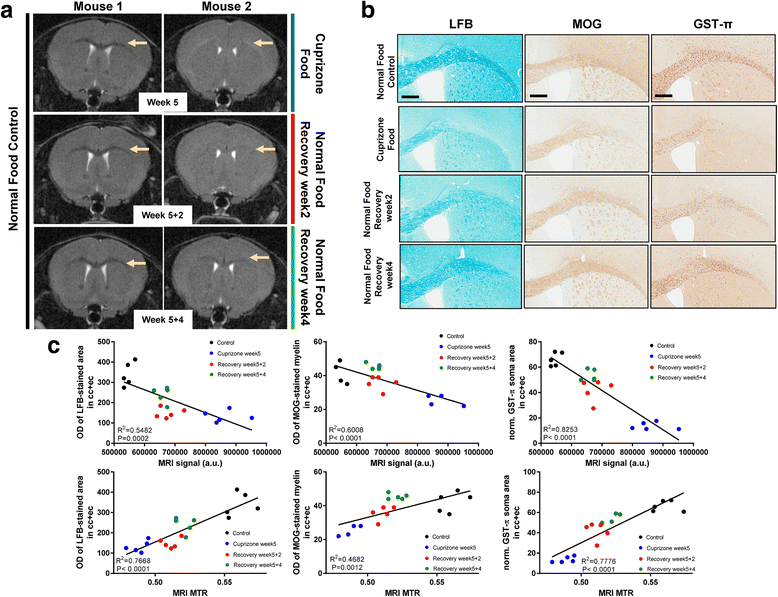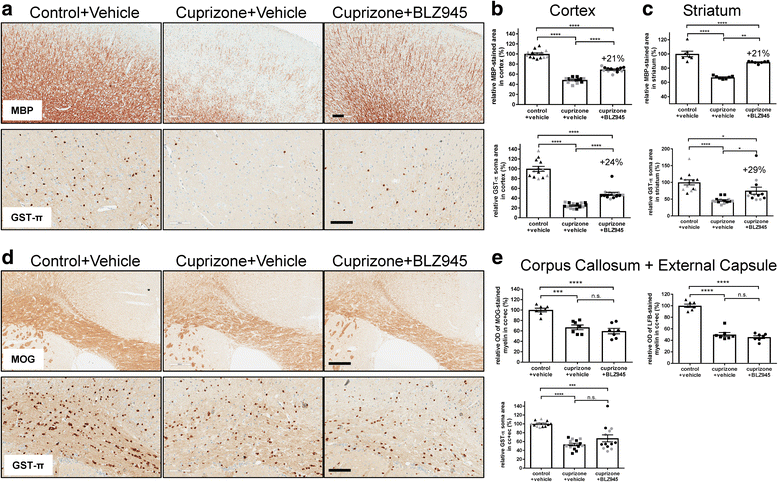Brain region-specific enhancement of remyelination and prevention of demyelination by the CSF1R kinase inhibitor BLZ945
- PMID: 29448957
- PMCID: PMC5815182
- DOI: 10.1186/s40478-018-0510-8
Brain region-specific enhancement of remyelination and prevention of demyelination by the CSF1R kinase inhibitor BLZ945
Abstract
Multiple sclerosis (MS) is a chronic inflammatory disease affecting the central nervous system (CNS). While multiple effective immunomodulatory therapies for MS exist today, they lack the scope of promoting CNS repair, in particular remyelination. Microglia play a pivotal role in regulating myelination processes, and the colony-stimulating factor 1 (CSF-1) pathway is a key regulator for microglia differentiation and survival. Here, we investigated the effects of the CSF-1 receptor kinase inhibitor, BLZ945, on central myelination processes in the 5-week murine cuprizone model by non-invasive and longitudinal magnetic resonance imaging (MRI) and histology. Therapeutic 2-week BLZ945 treatment caused a brain region-specific enhancement of remyelination in the striatum/cortex, which was absent in the corpus callosum/external capsule. This beneficial effect correlated positively with microglia reduction, increased oligodendrocytes and astrogliosis. Prophylactic BLZ945 treatment prevented excessive demyelination in the corpus callosum by reducing microglia and increasing oligondendrocytes. In the external capsule oligodendrocytes were depleted but not microglia and a buildup of myelin debris and axonal damage was observed. A similar microglial dysfunction in the external capsule with an increase of myelin debris was obvious in triggering receptor expressed on myeloid cells 2 (TREM2) knock-out mice treated with cuprizone. Finally, therapeutic BLZ945 treatment did not change the disease course in experimental autoimmune encephalomyelitis mice, a peripherally driven neuroinflammation model. Taken together, our data suggest that a short-term therapeutic inhibition of the CSF-1 receptor pathway by BLZ945 in the murine cuprizone model enhances central remyelination by modulating neuroinflammation. Thus, microglia-modulating therapies could be considered clinically for promoting myelination in combination with standard-of-care treatments in MS patients.
Keywords: Astrocyte; BLZ945; CSF1R kinase; Cuprizone; Microglia; Multiple sclerosis; Myelination; Neuroinflammation; Oligodendrocyte; TREM2.
Conflict of interest statement
Competing interests
All authors are, or have been, employees and shareholders of Novartis Pharma AG, Basel Switzerland.
Publisher’s Note
Springer Nature remains neutral with regard to jurisdictional claims in published maps and institutional affiliations.
Figures







References
-
- Brück W, Pförtner R, Pham T, Zhang J, Hayardeny L, Piryatinsky V, Hanisch U-K, Regen T, van Rossum D, Brakelmann L, Hagemeier K, Kuhlmann T, Stadelmann C, John GR, Kramann N, Wegner C. Reduced astrocytic NF-κB activation by laquinimod protects from cuprizone-induced demyelination. Acta Neuropathol. 2012;124:411–424. doi: 10.1007/s00401-012-1009-1. - DOI - PMC - PubMed
MeSH terms
Substances
LinkOut - more resources
Full Text Sources
Other Literature Sources
Molecular Biology Databases
Research Materials
Miscellaneous

